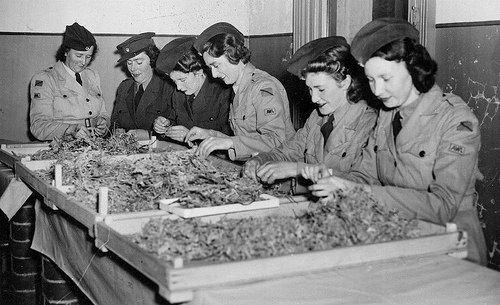2.3. Dorothy Lawrence: a woman at war
Rellenar huecos

1. Match the words and phrases (1 - 6) with their meaning (a - e).
Actividad de lectura

2. Look at the four sections of the story and put them in the correct order.
|
Extract A Dorothy wrote about her experiences, in a book titled ‘Sapper Dorothy Lawrence: The Only English Woman Soldier’. However, the book was suppressed by the War Office, and wasn’t published until 1919, after the war was over. She moved to Islington, in North London in 1919 and not much is known about her life after that. She was institutionalised in a psychiatric hospital in 1925 after accusing her church guardian of rape. She died at the Friern Hospital in London in 1964. Dorothy’s story was not well-known until her story was discovered more than eighty years later by the grandson of one of her accomplices, Richard Samson. He found out about her story while he was doing research about his family at the Royal Engineering Museum. Although she is not famous, her influence can be seen in the motivation she has given to other female war correspondents. |
|
Extract B The stress of living a double life and doing a very dangerous job was very difficult for Dorothy. She was also constantly worried that she would be caught, and that the men who had helped her would be in danger. As a result of this, and the terrible weather, she became ill with chills and rheumatism. She confided her situation to a sergeant in her regiment, who she thought she could trust. She was wrong – he reported her to the authorities. She was immediately arrested and interrogated as a spy. She was declared a Prisoner of War and taken to Calais for further questioning. The army was very embarrassed that a woman had managed to work on the front line and was worried that, if Dorothy’s story was known, other women would try to copy her. As a result, she was moved to a convent in Saint Omer, and kept there until she signed an affidavit, promising not to write about her experiences until the war had ended. She was very disappointed, as this was why she had travelled to the front – "in making that promise I sacrificed the chance of earning by newspaper articles written on this escapade”. |
|
Extract C Dorothy Lawrence was born in Warwickshire on 4th October 1896. She was abandoned by her mother and became a guardian of the Church of England. When the war began, she was 19 and living in Paris. She was keen to take an active role in the war and wanted to work as a war correspondent, reporting for the newspapers about what was happening on the front line. She had already had some success as a reporter as she had had some articles published in The Times newspaper. She contacted several British newspapers to see if she could write for them but she couldn’t get work as it was considered too dangerous even for men. She also tried to find work with the Voluntary Aid Department, who sent women to participate in war work but was unsuccessful. As a result, she made a plan to travel to the front line and write about her experiences there, saying “I’ll see what an ordinary English girl, without credentials or money can accomplish”. On her first attempt, she was arrested by French police two miles from the front line and ordered to leave the area. |
|
Extract D Her second attempt was more successful. She befriended two British soldiers, who became known as her ‘khaki accomplices’ and taught her how to drill and march like a soldier. Two Scottish soldiers she met at a train station gave her a military haircut and she dyed her skin with furniture polish so that she looked as if she had a sun tan. Her friends also gave her a uniform which they stole from the laundry in their regiment. Using forged papers with the name of Private Denis Smith of the First Battalion Leicestershire Regiment, she travelled to the Somme by bicycle. When she arrived, she made friends with a miner from Lancashire, Tom Dunn, who found her work as a sapper with the British Expeditionary Force Tunnelling Company. She was responsible for laying mines within 400 metres of the front line, where she was under constant fire. At night, she slept in an abandoned cottage that her friend, Tom Dunn, had found for her. |
Source: http://www.teachingenglish.org.uk/article/dorothy-lawrence-a-woman-war
Actividad desplegable

3. Look at the completed story. Add the headings (a-e) to the correct sections of the text (1-4). Please note: there are four sections, so there is one heading you don’t need.
Actividad de lectura
4. Look at the story again. Find words in the text that have the same meaning as the phrases below.
1) made friends with (section 2)
2) asked questions in an angry or threatening way to get information from someone (section 3)
3) to tell someone a secret or discuss your private feelings with them (section 3)
4) a legal document promising that something is true (section 3)
5) stopped information from being published or publicly discussed (section 4)
